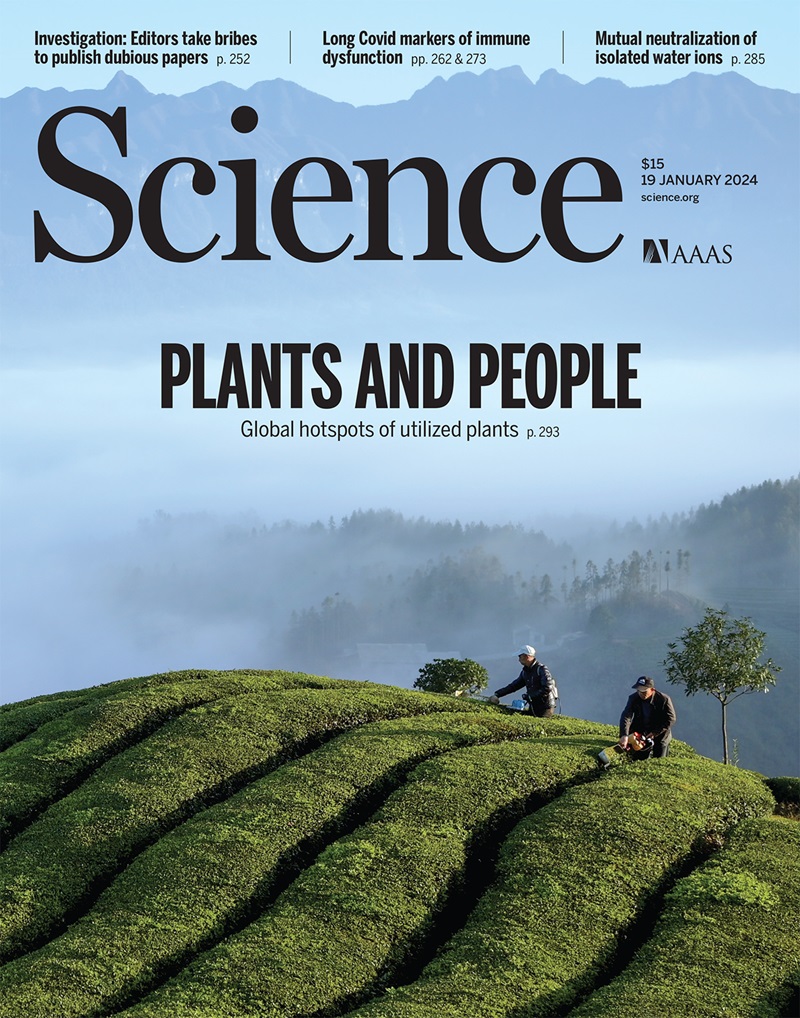RNA-mediated CRISPR-Cas13 inhibition through crRNA structural mimicry
IF 44.7
1区 综合性期刊
Q1 MULTIDISCIPLINARY SCIENCES
引用次数: 0
Abstract
To circumvent CRISPR-Cas immunity, phages express anti-CRISPR factors that inhibit the expression or activities of Cas proteins. Whereas most anti-CRISPRs described to date are proteins, recently described small RNAs called RNA anti-CRISPRs (rAcrs) have sequence homology to CRISPR RNAs (crRNAs) and displace them from cognate Cas nucleases. In this work, we report the discovery of rAcrVIA1—a plasmid-encoded small RNA that inhibits the RNA-targeting CRISPR-Cas13 system in its natural host, Listeria seeligeri. We solved the cryo–electron microscopy structure of the Cas13-rAcr complex, which revealed that rAcrVIA1 adopts a fold nearly identical to crRNA despite sharing negligible sequence similarity. Collectively, our findings expand the diversity of rAcrs and reveal an example of immune antagonism through RNA structural mimicry.
通过crRNA结构模拟介导的CRISPR-Cas13抑制
为了规避CRISPR-Cas免疫,噬菌体表达抑制Cas蛋白表达或活性的抗crispr因子。尽管迄今为止描述的大多数抗CRISPR是蛋白质,但最近描述的称为RNA抗CRISPR (rAcrs)的小RNA与CRISPR RNA (crrna)具有序列同源性,并将其从同源Cas核酸酶中取代。在这项工作中,我们报告了在其天然宿主李斯特菌seeligeri中发现的抑制RNA靶向CRISPR-Cas13系统的racrvia1 -一种质粒编码的小RNA。我们解决了Cas13-rAcr复合体的低温电镜结构,结果显示,尽管具有微不足道的序列相似性,但rAcrVIA1采用与crRNA几乎相同的折叠。总的来说,我们的发现扩大了rAcrs的多样性,并揭示了通过RNA结构模仿进行免疫拮抗的一个例子。
本文章由计算机程序翻译,如有差异,请以英文原文为准。
求助全文
约1分钟内获得全文
求助全文
来源期刊

Science
综合性期刊-综合性期刊
CiteScore
61.10
自引率
0.90%
发文量
0
审稿时长
2.1 months
期刊介绍:
Science is a leading outlet for scientific news, commentary, and cutting-edge research. Through its print and online incarnations, Science reaches an estimated worldwide readership of more than one million. Science’s authorship is global too, and its articles consistently rank among the world's most cited research.
Science serves as a forum for discussion of important issues related to the advancement of science by publishing material on which a consensus has been reached as well as including the presentation of minority or conflicting points of view. Accordingly, all articles published in Science—including editorials, news and comment, and book reviews—are signed and reflect the individual views of the authors and not official points of view adopted by AAAS or the institutions with which the authors are affiliated.
Science seeks to publish those papers that are most influential in their fields or across fields and that will significantly advance scientific understanding. Selected papers should present novel and broadly important data, syntheses, or concepts. They should merit recognition by the wider scientific community and general public provided by publication in Science, beyond that provided by specialty journals. Science welcomes submissions from all fields of science and from any source. The editors are committed to the prompt evaluation and publication of submitted papers while upholding high standards that support reproducibility of published research. Science is published weekly; selected papers are published online ahead of print.
 求助内容:
求助内容: 应助结果提醒方式:
应助结果提醒方式:


